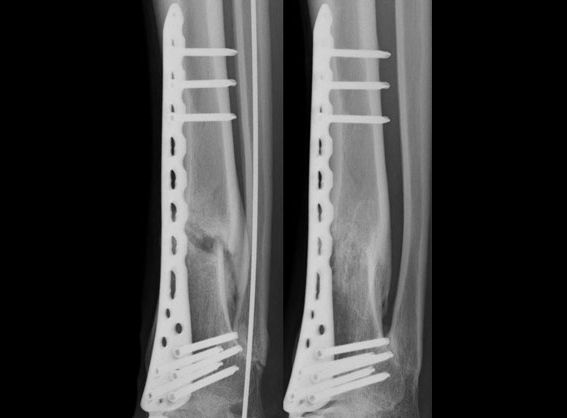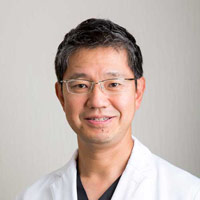The 5 to 10 per cent of fractures that won’t heal could be mended through a new approach to bone growth that spares patients multiple surgical procedures.
A research team led by Ryosuke Kuroda from the Department of Orthopaedic Surgery at Kobe University in Japan noted that fractures receiving inadequate blood flow were less likely to heal. Surgeons typically restore local blood flow in these cases through complex vascular procedures or soft tissue transfers, Kuroda explained.

Radiographs of stubborn fractures before (left) and after (right) treatment with stem cells.
Reproduced, with permission, from Ref. 1 © 2013 Kuroda Ryosuke et al.
In recent years, cell therapy has been used as an alternative strategy for bone fracture healing.
Early preclinical studies by Kuroda’s team, in collaboration with Japan’s Translational Research Informatics Center, showed that CD34+ stem cells derived from the bone marrow were particularly promising as they were able to improve blood supply to the bone as well as stimulate bone formation.
The research team used these stem cells in a pilot trial of seven patients with fracture of the femur or tibia bone that had failed to heal over a nine-month period1. The results were published in 2013.
During the study, each of the patients received an injection of granulocyte colony stimulating factor (GCSF), which stimulated their bone marrow to produce the CD34+ stem cells and release them into the blood stream.
The researchers harvested the cells and placed them in a gel that was then transplanted at the fracture site during a graft procedure using the patient’s own bone cells.
Three months after the procedure, five of the seven patients’ fractures had healed based on evidence from x-rays, CT scans and the patients’ clinical symptoms.
The two patients whose fractures had not healed went on to recover at 19 and 36 weeks.
None of the patients experienced side-effects. One patient was diagnosed with an abnormal growth in the cervix at a 12-month review, but it was unclear if this was related to the stem cell procedure.
“The results are exciting because they show that the cell therapy improves bone healing and shortens the length of time it takes for patients’ fractures to heal,” says Kuroda.
The researchers noted that since the patients had also received a bone graft, future studies would be needed to assess the feasibility and overall safety of the stem cell therapy alone.
The team have begun a multi-centre clinical trial to gain pharmaceutical approval for the cell therapy in Japan.
References
- Kuroda, R., Matsumoto, T., Niikura, T., Kawakami, Y., Fukui, T. et al. Local transplantation of granulocyte colony stimulating factor-mobilized CD34+ cells for patients with femoral and tibial nonunion: Pilot clinical trial. Stem Cells Translational Medicine 3, 128–134 (2014). | article
About the Researcher

Ryosuke Kuroda, Associate Professor, Kobe University
Ryosuke Kuroda is a leading knee surgeon in Japan with a special interest in the use of stem cells to repair cartilage damage. His research interests also include the biology and biomechanics of the knee joint and anterior cruciate ligament (ACL) reconstruction.




